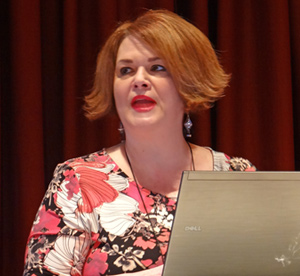
Specialty Medication Tools & Tactics for Employers
Employers can use tools and tactics to address the high cost of specialty medication while still delivering their benefits to employees and family members.
Cheryl Larson, vice president of the Midwest Business Group on Health (MBGH. External Link. Opens in new window.), and Wayne Salverda, a registered pharmacist and senior director of clinical services for WisconsinRx/National. External Link. Opens in new window.
CooperativeRx, shared their insights at The Alliance Learning Circle on “Doses and Dollars: Strategies for Specialty Drugs and Medication Adherence,” held March 17 at Monona Terrace in Madison. The event was co-sponsored by Merck and WisconsinRx/National CooperativeRx.
A High Priority

Larson said 96 percent of employers were “very concerned” about specialty drug costs based on preliminary results of the 2014 MBGH annual survey of employer members.
Specialty medications are expensive to develop and bring to market, which means they are also expensive for patients and health benefit plans. The drugs producing the most income for manufacturers address rheumatoid arthritis, multiple sclerosis and cancer. Other drugs treat hepatitis C, HIV/AIDs, hemophilia and cystric fibrosis.
Larson put the average cost of specialty drugs today at $1800, compared to the $50 to $155 price tag for many traditional prescriptions. Specialty drugs require special handling and administration, often through injections or infusions.
Employers’ Top Concerns about Specialty Medication
Preliminary results from the 2014 MBGH Employer Survey
| Issues | Concerns |
|
|
Source: MBGH
Seeking Relief
Larson said biosimilars could offer some relief, but warned employers against assuming they will deliver the same level of savings as generics that are often easily swapped in as substitutes for more expensive brand-name medications.

Biosimilars are not identical to the specialty medications that treat the same conditions, nor are they interchangeable. Instead, Larson said, the hope is that they will be effective enough to use in some situations, which would result in cost savings estimated at 10 to 30 percent over specialty medications.
Looking at your overall strategy is crucial, Larson noted.
“You really need to take a critical look at your PBM strategy today,” she noted.
MBGH’s survey also identified six tactics that employers have used with employees to manage specialty pharmacy costs. In order of effectiveness, they are:
- Prior authorization
- Case management
- Cost sharing
- Limited fill supply
- Required use of a specialty pharmacy
- Carving out the specialty benefit
Larson noted that employers have also used programs linked to financial incentives for employees. They include incentives for using a less-expensive site of care, such as having infusion therapy at home instead of the hospital; using a specialty pharmacy; offering case management services; or using “step therapy” for oral specialty drugs purchased at a retail pharmacy. “Step therapy” requires the use of lower-cost drugs before moving on to higher-cost drugs.
The MGBH Toolkit
MBGH worked with other coalitions nationwide as part of the Employer Initiative on Specialty Pharmacy to develop annual surveys, an employer toolkit and educational resources. The specialty toolkit is free online at www.specialtyrxtoolkit.com. External Link. Opens in new window..
MBGH works with five other employer coalitions and MBGH member employers to create pilot projects that test strategies for managing specialty medications. Pilots are aimed at ensuring high-quality case/care management; improving adherence; using value-based benefit design; offering incentives to patients to use a specialty pharmacy; using limited-fill strategies such as a seven to 10-day supply for a first-time prescription; and using step therapy to improve outcomes and medication adherence.
“We’re trying to stop the shenanigans that take place with some suppliers in the marketplace,” Larson added.
Initiatives for the coming year will include strengthening consumer communications; creating an assessment/audit process for PBM vendor selection; and identifying strategies for managing the site of care.
WisconsinRx/National CooperativeRx

Salverda said creating an effective specialty medicine strategy helped WisconsinRx/National CooperativeRx achieve a spending trend increase of 8.7 percent in 2014, compared to 12.7 percent for CVS nationwide.
“You’ve got two extremes: specialty drugs and traditional drugs,” Salverda said. “You really need to manage both of those.”
In some situations, managing traditional drugs effectively can achieve as much or greater return than management of specialty medications, Salverda said. For example, while many compounding pharmacies are ethical organizations, there are some that are actively managed as “money-making opportunities.”
Compounding is the term used to describe the practice of having a licensed pharmacist combine or mix ingredients to create a medication that is tailored to the patient. Some compounding pharmacies actively market unproven treatments to physicians or patients with difficult-to-treat conditions such as chronic pain. A good PBM partner can help employers create strategies to control the use of compounded medications.
“Proactive management on this front is a must,” Salverda said.
Looking at Hepatitis C
Hepatitis C made headlines in 2014 because of the $84,000 price tag attached to a typical course of treatment with the drug Sovaldi, which cures more than 90 percent of patients without the severe side effects that are typically part of using older Hepatitis C treatments.
Salverda said 3 million American adults are infected with Hepatitis, with as many as three out of four people who have the disease unaware that they have it. That means there is a huge market for future Hepatitis C treatment. Because the ACA sets an annual limit of $6,600 on what individuals can be asked to pay, employers and other payers will pay the rest of the cost.
Salverda noted that specialty medications often carry a high development cost, typically about $2.6 billion for research and development. Less than 20 percent of specialty medications successfully reach the market; 74 drugs aimed at Hepatitis C failed, while only 12 made it to the marketplace.
For those drugs that survive the development pipeline, Salverda noted that the Biologics Price Competition and Innovation Act of 2009 sets a 12-year exclusivity period for new specialty drugs. That means there is typically a long span before cheaper alternatives are available.
‘Best in Class’ Specialty Management
Employers are likely to face more specialty medication challenges in the years ahead. Salverda suggested that employers use these strategies for best-in-class management of specialty medications.
- Evidence-based guidelines
- Specialty preferred drug strategies
- Exclusive pharmacy providers
- Specialty cost share tier, which place specialty drugs in tiers where the patient is asked to pay a specific share of the cost.
- Day’s supply limits, which limit the supply of medication that can be obtained to a short period, such as seven or 10 days. This limit may vary based on initial or early usage, when side effects are most likely to impact adherence, or ongoing usage.
- Channel or medical management, which employers can use to keep claims out of the medical plan and within the pharmacy plan.
- Site of care management, which determines where treatments such as injections or infusions take place so that patients are encouraged to use sites that are lower-cost but still high quality.
Adherence Matters
Salverda provided a reminder of the importance of adherence, with studies showing that payers spend less on total care for patients who take medicine as prescribed.
Salverda said WisconsinRx and several of its member employers participated in a pilot program that compared the effectiveness of three strategies: a pillbox that allows patients to sort out medications for a seven-day period, a daily reminder tool that can be attached to a prescription pill bottle; and a special cap that shows how long it has been since a prescription pill bottle was last opened.
The pilot project showed that:
- People who follow a simpler drug regimen, such as one pill a day, will benefit more from these strategies.
- Those who had worse adherence when the project started had a greater benefit from using the strategies.
- Patients preferred the pillbox.
Salverda said that shows that when you’re looking for strategies to improve adherence, “Don’t overlook the little things.”
[box]
Learn More about Specialty Medication Tools
- Seeking Value: Managing Specialty Medications and Medication Adherence
- Specialty Drugs, Biosimilars and Your Benefit Plan
- View Resources from our 2018 Annual Meeting, Keeping a Lid on Specialty Rx Costs
[/box]







